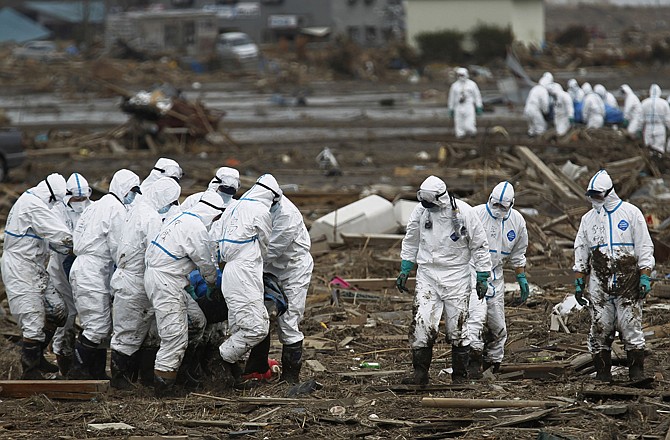TOKYO (AP) - Japan ranked its nuclear crisis at the highest possible severity on an international scale - the same level as the 1986 Chernobyl disaster - even as it insisted Tuesday that radiation leaks are declining at its tsunami-crippled nuclear plant.
The higher rating is an open acknowledgement of what was widely understood already: The nuclear accident at the Fukushima Dai-ichi plant is the second-worst in history. It does not signal a worsening of the plant's status in recent days or any new health dangers.
Still, people living nearby who have endured a month of spewing radiation and frequent earthquakes said the change in status added to their unease despite government efforts to play down any notion that the crisis poses immediate health risks.
Miyuki Ichisawa closed her coffee shop this week when the government added her community, Iitate village, and four others to places people should leave to avoid long-term radiation exposure. The additions expanded the 12-mile zone where people had already been ordered to evacuate soon after the March 11 tsunami swamped the plant.
"And now the government is officially telling us this accident is at the same level of Chernobyl," Ichisawa said. "It's very shocking to me."
Japanese nuclear regulators said the severity rating was raised from 5 to 7 on an international scale overseen by the International Atomic Energy Agency due to new assessments of the overall radiation leaks from the Fukushima Dai-ichi plant.
According to the Vienna-based atomic energy agency, the new ranking signifies a major accident that includes widespread effects on the environment and people's health. The scale, designed by experts convened by the IAEA and other groups in 1989, is meant to help the public, the technical community and the media understand the public safety implications of nuclear events.
The upgraded status did not mean radiation from the plant was worsening, but rather reflected concern about long-term health risks as it continues to spew into the air, soil and seawater. Most radiation exposures around the region haven't been high enough yet to raise significant health concerns.
Workers are still trying to restore disabled cooling systems at the plant, and radioactive isotopes have been detected in tap water, fish and vegetables.
Iitate's town government decided Tuesday to ban planting of all farm products, including rice and vegetables, expanding the national government's prohibition on growing rice there.
Japan's prime minister, Naoto Kan, went on national television and urged people not to panic.
"Right now, the situation of the nuclear reactors at the Fukushima plant has been stabilizing step by step. The amount of radiation leaks is on the decline," he said. "But we are not at the stage yet where we can let our guard down."
Japanese officials said the leaks from the Fukushima plant so far amount to a tenth of the radiation emitted from Chernobyl, but about 10 times the amount needed to reach the level 7 threshold. They acknowledged the emissions could eventually exceed Chernobyl's, but said the chance that will happen is very small. However, regulators have also acknowledged that a more severe nuclear accident is a distinct possibility until regular cooling systems are restored - a process likely to take months.
"Although the Fukushima accident is now at the equal level as Chernobyl, we should not consider the two incidents as the same," said Hiroshi Horiike, professor of nuclear engineering at Osaka University. "Fukushima is not a Chernobyl."
In Chernobyl, in what is now the Ukraine, a reactor exploded on April 26, 1986, spewing a cloud of radiation over much of the Northern Hemisphere. A zone about 19 miles around the plant was declared uninhabitable.
Thirty-one men died mostly from being exposed to very high levels of radiation trying to contain the accident. But there is no agreement on how many people are likely to die of cancers caused by its radiation.
No radiation exposure deaths have been blamed on the leaks at Fukushima Dai-ichi. Two plant workers were treated for burns after walking in heavily contaminated water in a building there.
NISA officials said they raised the incident level because of the cumulative amount of radioactive particles released into the atmosphere. Other factors included damage to the plant's buildings and accumulated radiation levels for its workers.

